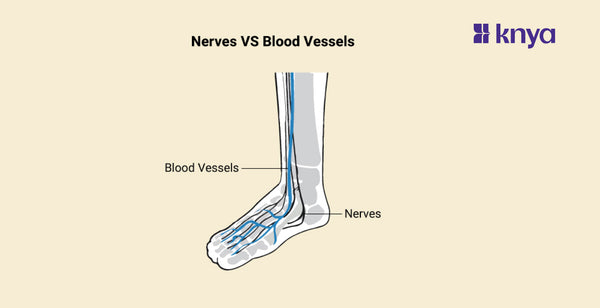Difference Between Nerves and Blood Vessels: Nerves and blood vessels are both important transportation systems in the body, yet they have significant distinctions. Nerves, which are part of the nervous system, function similarly to electrical cables, transmitting messages as impulses throughout the body. Blood vessels, on the other hand, are part of the circulatory system and transport blood, which distributes oxygen and nutrients to tissues while removing waste materials. Nerves essentially instruct the body on how to respond to electrical impulses, whereas blood vessels serve as highways for delivering resources and removing garbage.
Difference Between Nerves and Blood Vessels
Nerves and blood vessels are both crucial components of the human body's circulatory and nervous systems, respectively. Outlined are the differences between nerves and blood vessels:
|
Feature |
Nerves |
Blood Vessels |
|
Function |
Transmit electrical signals |
Transport blood |
|
Composition |
Neurons, axons, dendrites, nerve sheaths |
Endothelial cells, smooth muscle, connective tissue |
|
Structure |
Complex |
Relatively simpler |
|
Transport Medium |
Electrical impulses |
Blood |
|
Direction of Flow |
Bidirectional |
Unidirectional |
|
Response to Stimuli |
Sensation, muscle movement |
Blood flow regulation |
|
Role in Homeostasis |
Regulate bodily functions |
Regulate blood pressure, temperature, nutrient distribution |
|
Injuries |
Loss of sensation, muscle weakness |
Bleeding, reduced blood flow, tissue damage |
|
Regeneration |
Limited capacity for repair |
Higher capacity for repair |
|
Clinical Implications |
Neuropathy, multiple sclerosis, etc. |
Hypertension, atherosclerosis, etc. |
Order the Best Jogger Scrub from Here!
What are Nerves?
Nerves are a complicated network of cells that communicate throughout the body. They function similarly to electrical cables, carrying messages between the brain, spinal cord, and the rest of the body. These messages enable you to experience feelings, move your muscles, and react to your surroundings.
Browse Best Scrubs Collection
Key Features of Nerves:
- Nerves are the body's electrical messengers. They transmit information in the form of electrical impulses between the brain, spinal cord, and all body parts.
- Nerves are made up of several nerve fibres, each encased in an insulating sheath. This bundling preserves the sensitive fibres while ensuring fast, clear signal transmission.
- Nerves are classified into two types: sensory nerves, which transfer information about the environment (touch, temperature, pain, etc.) to the brain, and motor nerves, which transmit movement instructions from the brain to muscles.
- Nerves create a complicated, branching network throughout the body. This complicated system keeps all components in continual touch with the central nervous system.
What are Blood Vessels?
Blood vessels are a network of tubes that transport blood throughout the body. They play an important role in providing oxygen and nutrients to cells as well as eliminating waste. The three primary types of blood vessels are arteries, veins, and capillaries. Arteries transport blood away from the heart, veins return blood to the heart, and capillaries connect arteries and veins.
Explore All Women's Scrub
Key Features of Blood Vessels:
- Blood arteries are closed networks of tubes that convey blood throughout the body. Blood transports oxygen, nutrition, waste, and immune cells.
- There are three types of blood vessels: arteries transport oxygen-rich blood out from the heart, veins transport oxygen-depleted blood back to the heart, and capillaries are microscopic channels that exchange oxygen and nutrients with tissues.
- Arteries have robust, muscular walls to withstand the tremendous pressure of pumped blood, guaranteeing one-way flow to the tissues. Veins use thinner walls and valves to avoid backflow.
- Blood vessels serve an important part in maintaining the body's internal equilibrium (homeostasis) by providing needed nutrients and eliminating waste. They also serve to control body temperature and deliver hormones.
Shop Best Lab Coats from Here!
Similarities Between Nerves and Blood Vessels
- Nerves and blood vessels run throughout the body, producing vast networks.
- Both are necessary for the normal operation of body systems and organs.
- Both can be impacted by illnesses and abnormalities, resulting in a variety of health issues.
- Both are influenced by the autonomic nervous system to some degree.
- Both play important roles in maintaining homeostasis and reacting to internal and external stimuli.
- Each alters with age, with blood vessels stiffening and neurons possibly degenerating.
- Both may be seen and examined with medical imaging techniques including MRI, CT scans, and ultrasound.
- Both can be altered by lifestyle choices such as nutrition, exercise, and stress.
- Either can be used as therapeutic targets for a variety of illnesses and ailments.
Nerves and blood arteries, although creating intricate networks throughout the body, have quite distinct functions. Blood arteries, as part of the circulatory system, serve as a complicated highway for blood transport, supplying oxygen and nutrients to tissues while also transferring waste materials. Nerves, on the other hand, serve as an electrical communication grid and are part of the nervous system. They send electrical signals between the brain, spinal cord, and other body components, allowing us to feel, move, and respond to our surroundings. These basic contrasts underscore the two systems' unique functions in keeping us alive and functional.















